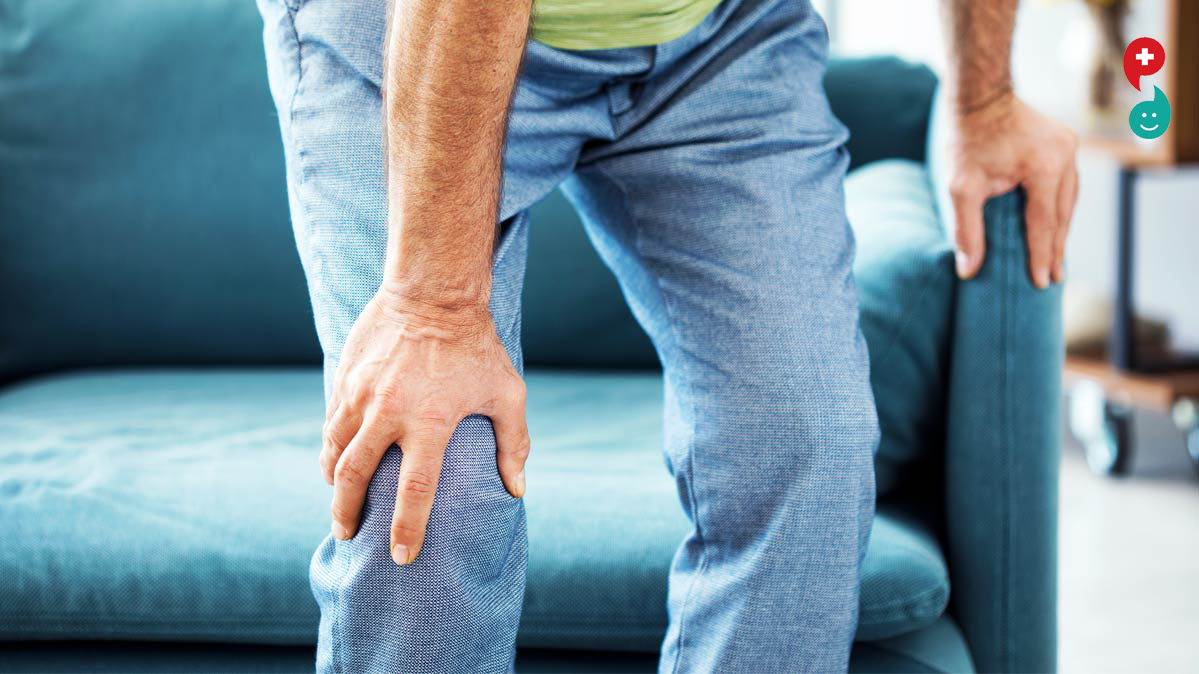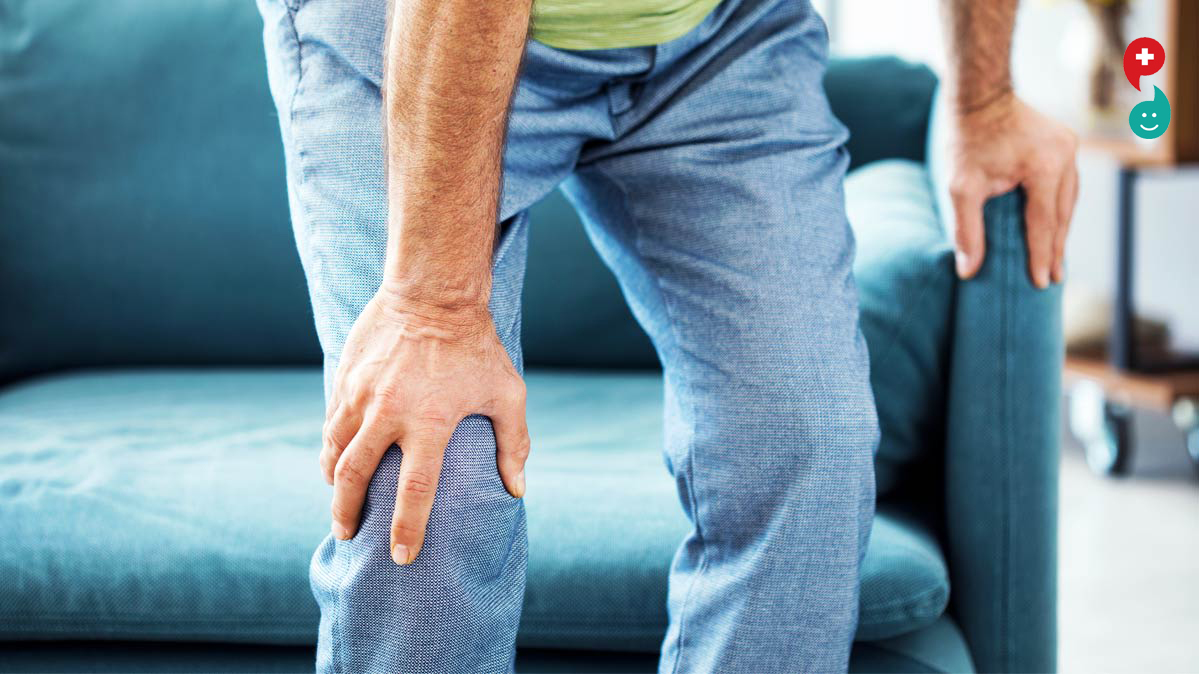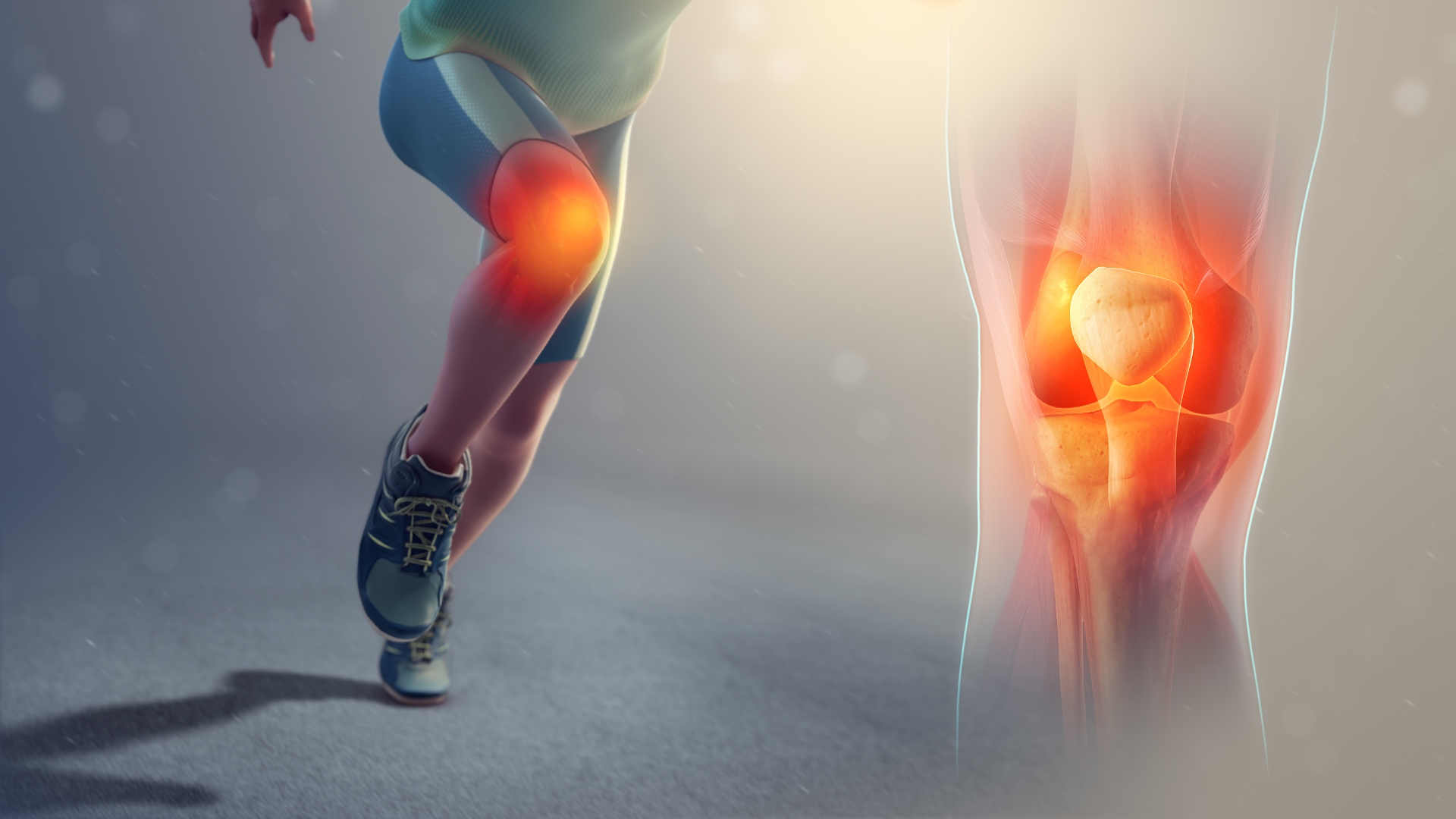Knee pain is an extremely common complaint. While unpleasant and frustrating, the upside is that knee pain is often a very treatable problem.
Diagnosing your knee pain first requires a focused medical history, one that sorts out the details of the pain, like what it feels like (e.g. aching, sharp, or burning), where it's located (e.g. front of or behind the knee), when it started (e.g., gradually or suddenly), and whether there was any recent trauma (e.g. blow to the knee).
Besides a medical history, your doctor will perform an examination of the knee joint and potentially order imaging tests to make or confirm a diagnosis.
In the end, understanding the precise cause of your knee pain is key to you and your doctor formulating an effective treatment plan—one that optimizes the knee healing process.
Causes
Your knee is a complex structure consisting of three bones—the lower part of the thighbone, the upper part of the shinbone, and the kneecap. Then, there are strong ligaments and tendons that hold these bones together, as well as cartilage beneath the kneecap and between the bones to cushion and stabilize the knee. Damage or disease that affects any of these structures may lead to pain.
Common
If you have knee pain, some common causes include:
Knee Arthritis
There are different types of arthritis that affect the knee joint, the two most common ones being osteoarthritis and rheumatoid arthritis.
Knee osteoarthritis develops as a result of "wear and tear" of the cartilage in the knee and is more common in people over the age of 50. As the cartilage deteriorates, pain develops, often gradually escalating from a sharp pain that worsens with knee movement to a constant dull, aching pain.
Rheumatoid arthritis is an autoimmune disease whereby a person's immune system attacks multiple joints in the body. In addition to pain, swelling, redness, and warmth over the kneecap may develop. Unlike osteoarthritis, knee pain from rheumatoid arthritis tends to improve with activity.
Knee Ligament Injuries
There are four ligaments in your knee—two collateral ligaments and two cruciate ligaments.
Collateral Ligament Injury
The collateral ligaments (medial collateral and lateral collateral) are found on the side of your knee and connect your thighbone (femur) to your lower leg bone. Injury to the medial collateral ligament (MCL) often results from a direct blow to the outside of the knee, which causes pain on the inside of the knee. A blow to the inside of the knee may cause a lateral collateral ligament (LCL) injury, which causes pain to the outside of the knee.
Cruciate Ligament Injury
The cruciate ligaments (anterior cruciate and posterior cruciate) cross each other inside the knee joint, with the anterior cruciate being in the front and the posterior cruciate being in the back. Anterior cruciate ligament injuries are the most common type of knee injury, often resulting from a direct blow or a sudden change in direction or speed when running. Usually, a "popping" noise is heard, along with sudden swelling, and a giving out of the knee.
Posterior cruciate ligament injuries are uncommon and are generally caused by some sort of high-energy force to the knee (for example, a bent knee colliding with the dashboard during a car accident). Besides pain at the back of the knee, knee swelling and stiffness are typical symptoms associated with this ligament injury.
Torn Knee Cartilage (Meniscus)
There are two "C" shaped, tough pieces of cartilage (called menisci) located between your thighbone and shinbone. Tearing of the meniscus is a common cause of knee pain and may occur in young people (often during sports) or older people, as the cartilage weakens with age making it more prone to tear. Besides pain, a person with a meniscus tear may initially hear a "pop" when the tear occurs. This is followed by a gradual development of knee stiffness and swelling, along with knee clicking, locking, or catching.
Patellar Tendonitis and Tear
Patellar tendonitis refers to inflammation of the patellar tendon—a large tendon that connects your kneecap to the top of our shinbone. Patellar tendonitis is most common in people who engage in sports or activities that require frequent running and jumping. Often times, people with this condition describes a constant dull pain that becomes sharp with activity.
Patellar tendonitis weakens the patellar tendon, making it more likely to tear. A patellar tendon tear causes severe pain, swelling over the knee, and a tearing or popping sensation. Depending on the degree of the tear, a person may notice an indentation at the bottom of the kneecap and experience walking difficulties due to the knee giving out.
Patellofemoral Pain Syndrome
Patellofemoral pain syndrome is most common in adolescents and young adults and is usually caused by vigorous activities that put stress on the knee, like running, squatting, or climbing stairs. This condition causes a dull, aching pain felt underneath the kneecap. Abnormal knee alignment may also cause or contribute to this condition. Besides pain, which worsens with activities that require frequent knee bending or sitting for long periods of time (for example, working at a desk), a person may note popping sounds in the knee when standing up from prolonged sitting or when climbing stairs. Knee swelling and locking are rarely seen with this syndrome.
Chondromalacia Patella
In some people with patellofemoral pain syndrome, a condition called chondromalacia patella is present, which means that the cartilage behind the kneecap has softened and begun to wear away. It develops as a result of overuse (i.e. bending the knee too much) or from a knee injury. Symptoms include pain, either sharp or aching, located in front of, around, and/or behind the kneecap.
Baker's Cyst
A Baker's cyst is swelling in the back of the knee joint and is sometimes a sign of another underlying problem such as a meniscus tear. While not all Baker's cysts cause pain, if they do, the "tightening" pain is felt in the back of the knee and is often associated with knee stiffness and a visible bulge that worsens with activity.
Prepatellar Bursitis
Your prepatellar bursa (a fluid-filled sac) is located right over the kneecap. Prepatellar bursitis—when the bursa becomes inflammed— is most commonly caused by people who frequently kneel, like gardeners or carpet layers. Less commonly, an infection, gout, rheumatoid arthritis, or a direct blow to the knee may cause bursitis. Besides a mildly aching knee pain that may only be felt with knee movement or when touching the affected area, rapid swelling over the kneecap typically occurs.
Iliotibial Band Syndrome
Iliotibial band syndrome refers to inflammation of the iliotibial band—a thick collection of fibers that runs along the outside of the thigh. Iliotibial band inflammation commonly happens as a result of overuse, especially in runners, and causes an aching, burning pain on the outside of the knee joint. Sometimes, the pain spreads up the thigh to the hip.
गुडघे दुखी (सांधेदुखी):
वाढत्या वयानुसार सांधेदुखी चा त्रास वाढायला लागतो. चालताना, उठताना व बसताना, काम करताना, वाकताना सांध्यांमध्ये त्रास होतो. अश्या वेळी सांधेदुखीवर घरगुती उपाय करून आराम मिळू शकतो.
सामान्य लक्षणे:
काम किंवा हालचाल करताना सांधे दुखणे, सांध्यावर सूज येणे, सकाळी उठल्यावर सांधे दुखने, विशेषतः हात पायाची बोटे जखडणे इत्यादी लक्षणे दिसून येतात.
सांधेदुखी मध्ये काय खावे:
गहू, तांदूळ, दुधी, दोडका, घोसाळे, तूर, मूग कुळीथ, द्राक्षे, कोहळा, दूध, तूप, लोणी, आले, लसूण, गरम पाणी इत्यादी पदार्थ आहारामध्ये समाविष्ट करावे.
काय खाऊ नये:
वरई, नाचणी, चवळी, वाल, पावटे, कारले, कैरी, कच्चा टोमॅटो, आंबट दही, चिंच, इडली, वैगैरे आंबवलेले पदार्थ खाण्याचे टाळावे.
कारणे
अतिलठ्ठपणामुळं गुडघ्याची समस्या वाढण्याचा धोका अधिक असतो. गुडघेदुखी पुढील कारणांनी देखील होतेः
- संधिशोथ
- गुडघ्यावर वारंवार दाब पडल्यामुळं होणाऱ्या वेदना (जसे बराचवेळ गुडघ्यावर वाकणे, अतिवापर, किंवा जखम).
- जिन्यावरुन वर-खाली जाण्यामुळं गुडघ्यातील वेदना आणखी तीव्र होत जाणे
- फाटलेली कूर्चा किंवा संधिबंध
- ताण किंवा खेचले जाणे
- गुडघ्याची वाटी सरकणे
- संधिमधे दाह होणे
- गुडघ्याला जखम होणे
- कटीतील समस्या –गुडघ्यात जाणवणारी वेदना इथे होऊ शकते.
- गुडघेदुखीला कारणीभूत ठरणा-या कमी सामान्य स्थितीमधे हाडात गाठ होण्याचा समावेश आहे.
सांधेदुखीवर घरगुती उपाय :
- सांधेदुखी चा त्रास असल्यास दोन चमचे बडीशोप व सुंठीचे तुकडा चार कप पाण्यामध्ये घालून एक कप राही पर्यंत उकळावे व अर्धा चमचा एरंडेल तेल घालून घ्यावे. - याप्रमाणे महिना भर केल्यास सांधेदुखीचा त्रास कमी होईल.
- दोन चमचे सुंठ व दोन चमचे एरंदमुळाची भरड चार कप पाण्यात उकळावे व एक कप पाणी राहिल्यावर गळून घ्यावे. व पिऊन घ्यावे. हा काढा नियमित घेतल्यास सांधेदुखी मध्ये निश्चित आराम मिडेल. याशिवाय याने परसाकडे साफ होऊन संध्यावरील सूज कमी होऊन वेदना कमी होतात.
- निर्गुडीची पाने पाण्यामध्ये उकळून त्याच्या वाफेने सांधा शेकल्यास सुज व वेदना कमी होतात.
- जर सांधा दुखत असेल तर मूठभर ओवा एरंडेल तलावर गरम करून सुटी कापडात बांधून पुरचुंडी करावी व त्याने दुखाणार सांधा शेकावा.
- सांधा सुजला असेल व वेदना होत असतील तर सूज व वेदना कमी करण्यासाठी एरंडची पाने वाफवून कुटून दुखत असलेल्या सांध्यावर बांधावे.
- रोजची कनिक मळताना चमचाभर एरंड तेलाचे मोहन घालून केलेली पोळी किंवा फुलका खावा. याने सांधेदुखीचा व सर्व सांधे संबंधित समस्या दूर होतात.
- अशक्तपणा मुले सांधे दुखत असल्यास मेथीचे व डिंकाचे लाडू नियमित खाल्ल्यास फायदा होतो.
- रात्री उशिरा भरपेट जेवण करू नये, वजन जास्त असल्यास कमी करावे, नियमित योगासने करावी, व सकाळी चालायला जावे. असे केल्यास सांधे दुखीचा त्रास होत नाही.
- तीळ व आयुर्वेदिक पद्धतीने बनवलेले तेल नियमित लावल्यास व आहारामध्ये योग्य प्रमाणात साजूक तूप समाविष्ट केल्यास शरीराचे स्नेहन होऊन सांधेदुखी कमी होते.
साएटिका या आजारात कंबरेपासून एका बाजूचा पार्श्वभाग, मांडीचा मागचा भाग आणि पोटरीत असह्य कळा येतात. या कळांबरोबरच या भागात मुंग्या, जडपणा आणि बधीरपणाही येऊ शकतो. आजार बळावल्यास पावलांमध्ये जडपणा आणि कमजोरी येते. साएटिका जर अगदी कमी प्रमाणात होत असेल, तर योग्य विश्रांती, योग्य व्यायाम काही आयुर्वेदीक उपाय उपयुक्त ठरू शकतात. ही वेदना खूपच त्रास द्यायला लागली, तर तिचं शास्त्रीय निदान करणं गरजेचं ठरतं.
कंबरेचा एक्स-रे आणि एमआरआय या दोन तपासण्या योग्य निदान होण्यास अतिशय उपयुक्त ठरतात. बऱ्याच रुग्णांमध्ये पायाकडे जाणारी नस मणक्यातून बाहेर पडतानाच दबली गेलेली असते. उभं राहिल्यावर आणि चालायला लागल्यावर ती अधिकच दबली जाते आणि या कळा असह्य प्रमाणात सुरू होतात. दोन मणक्यातली चकती घसरणं, मणके एकमेकांवर घसरणं, नस बाहेर पडताना दोन मणक्यांतल्या जागेत अतिरिक्त कॅल्शियम साठल्यानं चिंचोळी होणं, अशी अनेक कारणं या आजाराला कारणीभूत ठरतात. एमआरआयच्या चाचणीत नेमक्या कारणाचं निदान होतं. साएटिकाची वेदना असह्य होऊन रुग्ण बेजार झाल्यास लहानशा शस्त्रक्रियेनं व्यक्ती वेदनामुक्त होवू शकते. आधुनिक मायक्रोस्कोप किंवा एन्डोस्कोप (दुर्बिण) वापरून ही शस्त्रक्रिया पाऊण ते एक तासात संपते. यात लेझर आणि रेडिओ फ्रिक्वेन्सी यांसारख्या तंत्रज्ञानाची मदत होते. नेमक्या कोणत्या रुग्णाला शस्त्रक्रियेची गरज आहे, हे मात्र न्यूरोसर्जननं ठरवणं इष्ट ठरतं. दोन किंवा तीन टाक्यांत होणारी ही शस्त्रक्रिया अनेक रुग्णांना वेदनामुक्त करते.
साएटिका म्हणजे काय?
कंबरेच्या दोन मणक्यांमध्ये असलेली कुर्चा (डिस्क) घसरल्यामुळे कंबरेत निर्माण होणारी असह्य वेदना आपण कुणाला ना कुणाला होत असल्याचं नेहमीच पाहतो. याला स्लिप्ड डिस्क असं नाव आहे. दुर्दैवानं या आजारावरच्या उपचारांबद्दल जनमानसात असंख्य गैरसमज पसरलेले आपण पाहतो. यात पार्श्वभूमीवर या आजारावर उपलब्ध झालेल्या एका अत्याधुनिक आणि लोकोपयोगी उपचार पद्धतीची माहिती लोकांना व्हावी, म्हणून आपण त्यातल्या घटकांची सविस्तर माहिती घेऊ. कंबरेच्या मणक्यांमध्ये स्लिप्ड डिस्क (गादी, कुर्चा घसरणं) झाल्यास खालील लक्षणं दिसून येतात.
कंबरदुखी : विशेषतः बसल्यावर किंवा पुढे वाकण्याचा प्रयत्न केल्यास होणारी वेदना. ही अतिशय असह्य असू शकतो.
साएटिका : घसरलेली चकती पायाकडे जाणाऱ्या नसेत घुसल्यास पार्श्वभाग, मांडीचा मागचा भाग आणि पोटरीपर्यंत असह्य वेदना पसरू शकते. वेदनेबरोबरच मांडी आणि पायात मुंग्या येणं, जडपणा आणि बधिरता पसरू शकते.
क्लॉडिकेशन : घसरलेली चकती जर आणखी तीव्रतेनं दाब आणू लागली, तर हे लक्षण दिसतं. यात, थोडं अंतर चाललं की कंबर, मांड्या आणि पोटऱ्या भरून येतात. दुखू लागतात. मुंग्या, जडपणा आणि बधीरपणाही जाणवण्याची शक्यता असते. या लक्षणांमुळे रुग्णाला चालणं, थांबवणंच भाग पडतं.
घोटा आणि पावलातली शक्ती कमी होणं : अतिशय वाढलेल्या आजारात पायाच्या स्नायूत कमजोरी येऊन चालणं अशक्य होण्याची शक्यता असते. याला फूट ड्रॉप म्हणतात. स्लिप डिस्क या आजारात सुरुवातीला शस्त्रक्रियेशिवाय उपचार केले जातात हे खरं; पण वेदना तशाच सुरू राहिल्यास रुग्णाची अवस्था कठीण होते. रोजच वेदना सहन करत आयुष्य कंठण्याची वेळ त्याच्यावर येते. त्यातच समाजात या आजाराबद्दल अनेक गैरसमज आहेत. त्यामुळे शस्त्रक्रियेला घाबरून दुखणं सहन करण्याकडे अनेकांचा कल असतो. अनेकदा हे दुखणं मोठी शस्त्रक्रिया करण्याएवढं तीव्र नसतं. दैनंदिन जीवनात मात्र कायमचा त्रास उत्पन्न करणारं ठरतं. अशा रुग्णांसाठी कमी टाक्यांची मणक्याची शस्त्रक्रिया अत्यंत उपयुक्त ठरते.
सांधेदुखी/अर्थरायटिस ही आजकालची सामान्स समस्या उतारवयात अनेकांना त्रासदायक ठरते.
मुंबई : सांधेदुखी/अर्थरायटिस ही आजकालची सामान्स समस्या उतारवयात अनेकांना त्रासदायक ठरते. पूर्वी उतारवयात जाणवणाऱ्या या समस्येने सध्या तरुणाईही त्रासली आहे. तुम्ही देखील या समस्येला सामोरे जात असाल तर आहारात या पदार्थांचा समावेश करा. त्यामुळे समस्या दूर होण्यास नक्कीच मदत होईल.
लसूण
दैनंदिन आहारात लसणाचा अवश्य समावेश करा. याच्या सेवनाने अर्थरायटिस रुग्णांना फायदा होतो. यात असलेल्या अॅंटी-बॅक्टेरिअल, अॅंटी फंगल, अॅंटी बायोटिक आणि अॅंटी इंफ्लेमेट्री गुणधर्मांमुळे सांधेदुखीवर आराम मिळण्यास मदत होते. मात्र उन्हाळ्याच्या दिवसात लसणाच्या २ हुन अधिक पाकळ्या खावू नका. कारण लसूणही गरम असतो.
ब्रोकोली
पोषकघटकांनी परिपूर्ण अशी ब्रोकोली सांधेदुखीवर अतिशय फायदेशीर ठरते. यात कॅल्शियम, कार्बोहायड्रेट्स, प्रोटीन्स, आयर्न, व्हिटॉमिन ए-सी, क्रोमियम असते. त्यामुळे शरीर स्वस्थ राहण्यास मदत होते.
हळद
हळदीत करक्यूमिन नावाचे तत्त्व असते. त्यामुळे आजार पसरवणारे बॅक्टेरिया नष्ट होण्यास मदत होते. त्याचबरोबर सांधेदुखीवरही अत्यंत प्रभावी ठरते.
ओमेगा ३ अॅसिड
अर्थरायटिसपासून सुटका मिळवण्यासाठी ओमेगा ३ फॅटी अॅसिडचे सेवन करा. यासाठी आहारत मासे, फिश ऑईल याचा समावेश करा.
ही काळजी घ्या
फिरणे बंद करु नका.
नियमित व्यायाम करा.
फास्ट फूड आणि डबाबंद पदार्थांचे सेवन टाळा.
फॅट्सयुक्त पदार्थ खाणे टाळा.













